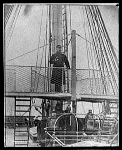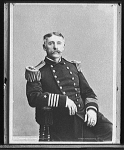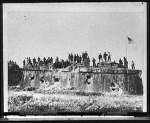Today in History: December 26
On a bright May morning two years ago there came from out the ocean mist an untried naval squadron, mirroring in the rippling waves the flag of the mistress of the Western world, the lustre of whose shining stars has never been dimmed by dishonor or defeat, seeking in Manila Bay the naval pride and power of Spain…from out the din and smoke of battle there arose a colossal figure, calm and majestic, cool and self-reliant…a naval hero, the splendor and brilliancy of whose achievement have written on the eternal tablet of fame…the immortal name of Admiral George Dewey."Address of Hon. Josiah T. Settle, Delivered at the Reception Given Admiral and Mrs. Dewey,"
Memphis, Tennessee, May 7, 1900.
African American Perspectives, 1818-1907
This flowery tribute captures the sense of romance with which turn-of-the-century Americans regarded the naval hero of the Spanish-American War, Commodore George Dewey. In actuality, Dewey did not arise from the "ocean mist" or the "smoke of battle" but was born in Montpelier, Vermont on December 26, 1837.

U.S.S. Pensacola, Captain Dewey on the Bridge, circa 1890-1901.
Touring Turn-of-the-Century America, 1880-1920
A graduate of the U.S. Naval Academy, Dewey served in the Union Navy during the Civil War, fighting in the Battles of New Orleans, Port Hudson, and Donaldsville, Louisiana. Dewey rose up steadily through the Navy's leadership ranks until Secretary of the Navy Theodore Roosevelt, in 1897, appointed him commander of the Asiatic Squadron stationed in Hong Kong.
Dewey made careful preparations for a battle with the Spanish fleet in the Pacific, departing for the Philippines on April 25, 1898, the day the U.S. declared war on Spain. Just before 6:00 A.M., on the morning of May 1, 1898, Commodore George Dewey commenced the Battle of Manila Bay, uttering the famous command, "You may fire when ready, Gridley."

U.S.S. Olympia, Captain Gridley
Edward H. Hart, photographer, circa 1895-1901.
Touring Turn-of-the-Century America, 1880-1920
Within six hours, Dewey's squadron of six ships, including the flagship U.S.S. Olympia, had sunk every ship in the Spanish fleet. There were few casualties and no loss of life on the American side. On August 13, 1898, U.S. troops occupied Manila, bringing the United States closer to an ultimate victory in the Spanish-American War.
Dewey's decisive victory at Manila on May 1, 1898, is credited with bringing the U.S. recognition as a major naval power. The acquisition of the Philippines gave the United States a strong presence in the Pacific. Commodore Dewey became a national hero, and his triumphant homecoming in 1899 was celebrated with wild enthusiasm.

American Troops on Ramparts at Manila
Edward H. Hart, photographer, circa 1898-1901.
Touring Turn-of-the-Century America, 1880-1920
As the Honorable Josiah Settle described it:
When, home at last, his gallant flagship lay anchored in the bay of the second city of the world, her teeming millions were mad with joy and impatience to do such honor to the hero of Manila as was never shown mortal man before; and it can be truly said that such unlimited display of loyal affection and costly magnificence as New York gave the home returning hero was greater than was ever shown before to any other man."Address of Hon. Josiah T. Settle, Delivered at the Reception Given Admiral and Mrs. Dewey,"
Memphis, Tennessee, May 7, 1900.
African American Perspectives, 1818-1907

U.S. Cruiser Olympia Leading Naval Parade during the Dewey naval parade on the Hudson River in New York City
Thomas A. Edison, Inc., Sept. 29, 1899.
The Spanish-American War in Motion Pictures
Thomas Edison's film crew was granted permission to film the extravagant "Dewey Day Doings." Several of these films are available for viewing in the American Memory collection The Spanish-American War in Motion Pictures, including those of the naval parade and the land parade. Although it takes some time to view these videos it is well worth the effort to see the celebrations through the "lens" of Dewey's contemporaries.
For more resources about Dewey and the Spanish-American War:
- Search the collection The Spanish-American War in Motion Pictures on the keyword Dewey to view several films. Don't miss that collection's Special Presentation, The Motion Picture Camera Goes to War: The Spanish-American War and the Philippine Revolution, regarding the first war documented in moving pictures.
- For an historical overview of the Spanish-American War, see The World of 1898: The Spanish-American War, a presentation from the Library of Congress Hispanic Division. This online presentation includes an event Chronology for the Philippine Islands and Guam in the Spanish-American War.
- Search the collection Touring Turn-of-the-Century America, 1880-1920 for photographs of all the ships of Admiral Dewey's flotilla and their captains. Examples of names are U.S.S. Olympia, U.S.S. Raleigh, and U.S.S. Texas. Among the items to be found here is an image of the U.S.S. Raleigh, [and] the Gun that Fired the First Shot at Manila.
- Search the Today in History Archive on Spanish American War to find other important events of that war, including the sinking of the U.S.S. Maine, the declaration of war on Spain, the landing at Guantánamo Bay, the storming of San Juan Hill, and the raising of the U.S. flag over Puerto Rico.
- Visit the educator's resource guide to the Spanish American War in the collection connections part of the Learning Page, an online resource designed to help teachers, students, and life-long learners use the American Memory collections.
- Search across all the American Memory collections on Spanish-American War to find a wealth of relevant photographs, maps and documents.